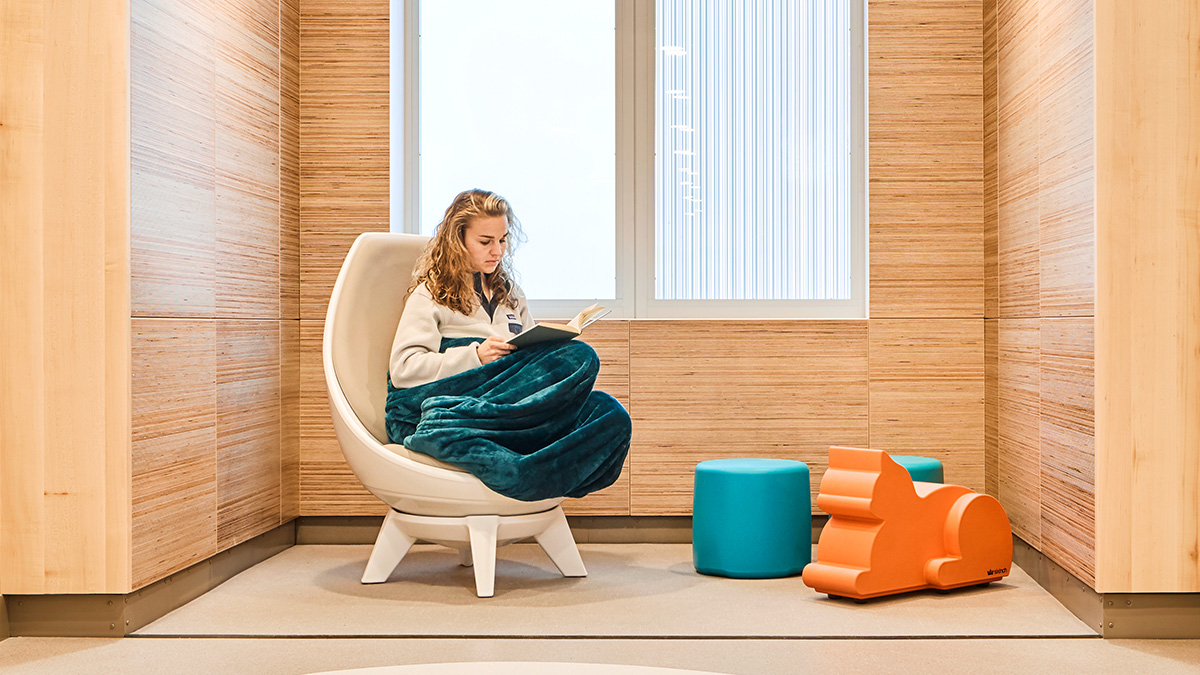How Healthcare Design Impacts Our Mental Health

May is Mental Health Awareness Month. Over the next few weeks, we’ll share a series of blog posts on how smart design can improve mental and emotional well-being in a variety of contexts.
First up is healthcare. How can we design spaces that meet the mental and emotional health needs of patients, loved ones and providers alike?
Healing with Friends and Family
Many of us turn to friends and family for comfort during difficult times. And some of the most difficult times we face can be at the hospital or in the doctor’s office.
Even routine appointments and preventive procedures can engender uncertainty and anxiety. When we face the prospect of a serious illness or a long course of treatment, a strong support system is even more important.
Hospitals and other clinical settings can significantly boost patients’ mental and physical well-being by creating space for their families. One study found that patients who had family at their bedside recovered more quickly. They also reported increased comfort and spent less time in the hospital.
Versatile furniture solutions can make it easier for friends and family to support their loved ones. Our Hiatus Sleeper Bench provides seating for up to three visitors as a couch, but it also easily converts to a trundle-style twin bed. As a bed, Hiatus provides a sleepover solution with home-like comfort, allowing overnight patient support.
It also offers optional storage and power outlets so visitors can store their belongings and charge their phones, tablets, laptops and the like.
Hiatus is ideal for maximizing limited space in hospital rooms. Its compact and highly mobile design enables healthcare professionals to easily relocate it to accommodate changing space needs. Its intuitive design allows visiting family to support their loved one even as the patient's needs evolve.
Taking Care of Caregivers
From nurses and doctors to social workers and therapists, medical professionals work tirelessly to keep their patients happy and healthy. But that also puts them at higher risk of experiencing burnout and mental health challenges. A survey of 1,100 healthcare professionals last year found that three in four felt anxious, burned out and overwhelmed. Nurses are diagnosed with clinical depression at twice the rate of the general population.
Thoughtful design can reduce the daily stress healthcare workers experience. For instance, smart floorplans that optimize the flow of traffic can lessen the amount of time doctors and nurses spend hustling from patient to patient.
Dedicated spaces for healthcare professionals to rest are crucial to preventing burnout as well. Our MyPlace Lounge Furniture collection includes lightweight seating and ottomans that make it easy for a group of nurses to create a custom lounge area where they can kick up their feet and decompress on their breaks.
Our Sway Lounge Seating allows individuals to rock front to back, side to side and everything in between. All that movement can soothe jagged nerves -- or help a provider recover after a tough shift.
Private, quiet spaces can provide a welcome reprieve for all healthcare workers but may be particularly useful for those who need a place to do confidential work -- or somewhere they can be alone with their thoughts. Our WiggleRoom pod, with its sound-absorbing panels and a magnetically-sealed door, can be just that kind of space for a harried doctor or nurse.
Mental Wellness During May and Beyond
This Mental Health Awareness Month, let’s commit to making mental health a year-round concern. At KI, we believe that starts with designing thoughtful, healthy spaces.
Subscribe
Stay up to date with the latest trends and more.








